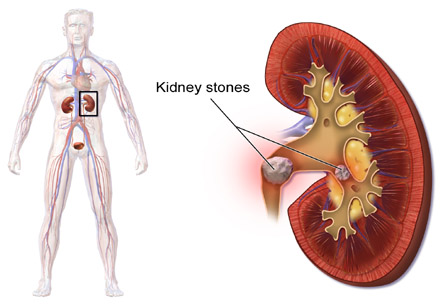Kidney Stone
Introduction
Formation of stones in kidneys is a relatively common complaint. It commonly occurs in middle aged and elderly people. It is more commonly seen male subjects. Various reasons may be responsible for formation of stones. Metabolic disorders, obstruction in the urinary tracts and pathways are some important reasons for formation of stones in kidneys. Stones in kidneys may or may not produce any symptoms. Common symptoms may be pain in the lower back and abdomen, urinary infections etc. These stones are identified either by a X ray or USG investigation.
Treatment:
Treatment of stones in kidneys depends on the size of the stone and its location. If the size is small then no treatment is required. The patient is prescribed pain killers occasionally and advised to drink plenty of water. Excess intake of fluid produces more urine that may drive out the stone through urine.
If the size of the stone is bigger, active interventions are required. Bigger size of the stones means they can block the urinary flow leads to infections and other complications. Procedures like lithotripsy or surgery is chosen. Proper evaluation of the patient is required to choose the mode of treatment. Size and number of stones need to be determined carefully.
An Iranian expert has been selected due to the country's progress in urology and for having preeminent experts

Lithotripsy is the most commonly used procedure. In this procedure shock waves are passed through the body to break the kidney stones. The procedure is usually painless where a device is used to pass the waves through the abdominal wall. They are not felt by the patient. Adequately broken stones are evacuated through urine.
Different types of surgical options are available to remove the stones. Careful evaluation is required to select a procedure. A thin tool (ureteroscope) through the urethra to view the urinary tube (ureter) and small stones may be removed by it. This is messentially a tin fiber optic tube with a camera at its tip. Under anesthesia the tube is inserted via the urethra into the bladder and the ureter. Stones that cannot be removed by ureteroscope are removed by other surgical procedures. Another procedure is called percuteneous nephrolithotomy. This process involves opening up of the abdomen to remove the stone. In this procedure an incision is made over the abdomen or at the back. The stone is dissected out of the obstruction and the ureters and skin is stitched back. This is needed for larger stone removals. Common side effects of the surgery includes risk of bleeding, infections, pain and anesthetic complications.
Once stone is removed adequate precautions are required to prevent recurrence of stones. Patients are advised to consume large amount of water. Dietary modifications and a healthy balanced diet are recommended for these patients.